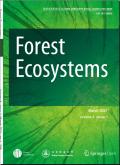Enhancing stem volume estimation for savanna species using variable-exponent taper equation and close-range photogrammetry
IF 4.4
1区 农林科学
Q1 FORESTRY
引用次数: 0
Abstract
Stem volume estimation is crucial in forest ecology and management, particularly for timber harvesting strategies and carbon stock assessments. This study aimed to develop a variable-exponent taper equation specifically tailored to savanna tree species using close-range photogrammetry (CRP) data and to evaluate its performance against conventional volume equations for stem volume estimation. A dataset of 30 trees across five dominant savanna species was used to fit the taper model, which was validated using a separate dataset of 322 trees from 14 species. The results demonstrated significant improvements in volume estimation accuracy when using the taper equation. At the tree level, the root mean square error (RMSE) decreased by 47%, from 598 to 319 dm3, and the mean absolute bias (MAB) by 48%, from 328 to 172 dm3, compared to volume equations. Similarly, at the plot level, RMSE was reduced by 42% and MAB by 40%. The model performed well for species with regular forms. However, species with irregular tapers exhibited higher errors, reflecting the challenges of modeling stem forms of mixed species. The use of CRP proved valuable, providing high-resolution diameter measurements that improved model parameterization. This study underscores the importance of advanced data collection methods for enhancing taper model accuracy and suggests that further species-specific adjustments are needed to improve performance for species with irregular forms. The findings support the broader application of taper equations for improving stem volume estimates in savanna ecosystems, contributing to better forest management and resource monitoring practices.
利用变指数锥度方程和近景摄影测量加强热带稀树草原物种茎体积估算
茎体积估算对森林生态和管理至关重要,特别是对木材采伐战略和碳储量评估。本研究旨在利用近距离摄影测量(CRP)数据建立一个专门针对热带草原树种的变指数锥度方程,并评估其与传统体积方程的性能。研究人员使用了5个主要稀树草原物种的30棵树的数据集来拟合锥度模型,并使用了来自14个物种的322棵树的单独数据集来验证该模型。结果表明,当使用锥度方程时,体积估计精度显着提高。与体积方程相比,在树的水平上,均方根误差(RMSE)从598 dm3下降到319 dm3,降低了47%,平均绝对偏差(MAB)从328 dm3下降到172 dm3,降低了48%。同样,在地块水平上,RMSE降低42%,MAB降低40%。该模型对规则形态的物种表现良好。然而,具有不规则锥度的物种表现出更高的误差,反映了混合物种的茎形态建模的挑战。CRP的使用证明是有价值的,它提供了高分辨率的直径测量,改进了模型参数化。该研究强调了先进的数据收集方法对提高锥度模型准确性的重要性,并表明需要进一步的物种特异性调整来提高不规则形状物种的表现。研究结果支持更广泛地应用锥度方程来改善热带草原生态系统的茎体积估算,有助于改善森林管理和资源监测实践。
本文章由计算机程序翻译,如有差异,请以英文原文为准。
求助全文
约1分钟内获得全文
求助全文
来源期刊

Forest Ecosystems
Environmental Science-Nature and Landscape Conservation
CiteScore
7.10
自引率
4.90%
发文量
1115
审稿时长
22 days
期刊介绍:
Forest Ecosystems is an open access, peer-reviewed journal publishing scientific communications from any discipline that can provide interesting contributions about the structure and dynamics of "natural" and "domesticated" forest ecosystems, and their services to people. The journal welcomes innovative science as well as application oriented work that will enhance understanding of woody plant communities. Very specific studies are welcome if they are part of a thematic series that provides some holistic perspective that is of general interest.
 求助内容:
求助内容: 应助结果提醒方式:
应助结果提醒方式:


